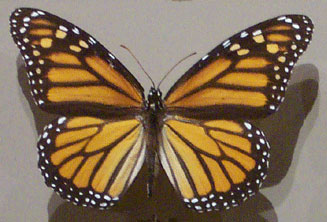Monarch butterfly migration threatened by illegal logging in Mexico
Monarch butterfly migration threatened by illegal logging in Mexico
mongabay.com
April 2, 2008
Destruction of forests in central Mexico, is putting the Monarch butterfly’s annual migration at risk, says a researcher from the University of Kansas.
Chip Taylor, a professor of ecology and evolutionary biology who leads Monarch Watch, a program that has tracked the monarch migration since 1992, says the destruction of the butterfly’s wintering home at the Monarch Biosphere Reserve could cause its annual migration to collapse.
“To lose something like this migration is to diminish all of us,” said Taylor. “It’s so truly spectacular, one of the awe-inspiring phenomena that nature presents to us. There is no way to describe the sight of 25 million monarchs per acre — or the sensation of standing in a snowstorm of orange as the butterflies cascade off the fir trees.”
More than half of the 217-square-mile Monarch Biosphere Reserve has been destroyed by illegal logging. Taylor says that armed loggers are taking advantage of high timber prices to extract timber from the isolated reserve.

|
“It’s a remote area, and it’s difficult to police,” Taylor said. “There are elements that are quite forceful in their logging. They carry guns. They overpower the local residents. They sneak in there at night, sometimes with 100 trucks, and clear out 2 or 3 hectares. And we’ve got the local residents contributing to this as well. Now that they’ve taken out most of the areas where the butterflies don’t occur, they’re going to be starting work on the areas where they do occur. This prospect is very ominous and is a serious threat to the overwintering population.”
“Since 2000, we’ve had the three lowest populations we’ve ever seen at these overwintering sites,” said Taylor. “On the surface, it looks like the population is going down. Previously, the population occupied 9 hectares. Now, we’re only averaging about 6 hectares per year. This year the population was 4.61 hectares — the third-lowest population.”
Taylor says monarchs are also threatened at the other end of their migration: in the United States.
“We’re developing this country at a very rapid pace with very little attention to wildlife,” Taylor said. “In addition, the widespread use of herbicides along roadsides, transgenic crops and expansion into biofuels is reducing habitats for wildlife. These sorts of losses have to be dealt with if we’re going to sustain this monarch population. We have to create new habitats and we have to protect the habitats we have.”
To reverse the decline, Taylor recommends cracking down on illegal logging and promoting reforestation in the Monarch Biosphere Reserve. Hiring of locals as park rangers could remove some of the incentives that drive logging.
In the United States, Taylor suggests that residents and city planners create Monarch habitat by planting milkweed, the plant that provides critical nourishment to the butterflies.
“The monarch migration is truly a wonder,” Taylor said. “Here, you have a fragile insect weighing a half a gram, with a tiny brain, that comes out of Mexico in the spring, migrates up to the breeding areas where it has several generations, then migrates back again to an area that the year’s last generation has never been to. There are lessons for life in this butterfly and we need to protect it. If we don’t, we’re pretty lousy stewards of this planet and it bodes poorly for our future.”
This article is based on a news release from Monarch Watch / the University of Kansas














